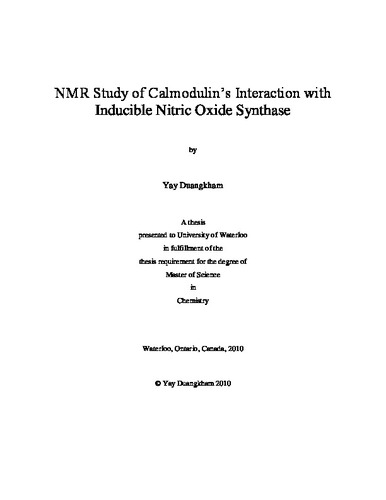| dc.description.abstract | The increase of calcium in the cell can induce cellular functions such as fertilization, cell division and cell communication. Calcium (Ca2+) carries out these processes through proteins called calcium sensors. An important calcium modulator is calmodulin. Calmodulin has four possible Ca2+ binding sites that have the characteristic helix-loop-helix (EF hand) motif. When the EF hands bind to Ca2+, methionine rich hydrophobic patches are exposed allowing for CaM to interact with target proteins. However, there are proteins that can interact with CaM at low levels of Ca2+ or in the absence of Ca2+.
An enzyme that is activated by CaM is nitric oxide synthase (NOS), which converts L-arginine to L-citrulline and nitric oxide (•NO), where •NO is used to carry out important cellular functions. There are three isoforms of the enzyme; endothelial, neuronal and inducible NOS. The first two isoforms are activated by Ca2+-bound CaM when there is an influx of Ca2+ and are therefore Ca2+-dependent whereas inducible NOS (iNOS) is activated and binds tightly to CaM regardless of the Ca2+ concentration and is therefore Ca2+-independent. Of particular interest is the iNOS enzyme, since no three-dimensional structures of the reductase domain or the CaM-binding region have been solved. All three isoforms of NOS exist as homodimers, where each monomer consisting of a reductase domain and an oxygenase domain separated by a CaM-binding region. The reductase domain contains binding sites for NADPH and the flavins, FAD and FMN, which facilitate electron transfer from the NADPH to the catalytic heme in the oxygenase domain of the opposite monomer. The transfer of electrons from the FAD to the heme is carried out by the FMN domain which is proposed to swing between the two docking points since the distance between the two points is too large for electron transfer. This electron transfer point is under the control of CaM, which is essential for NOS activation. This dynamic process and the direct role of CaM have yet to be observed structurally. A method to monitor dynamics structurally is through the use of nuclear magnetic resonance (NMR) spectroscopy. Therefore as the first step to determine the NMR structure of the FMN domain with the CaM-binding region, the structure of the iNOS CaM-binding region bound to CaM will be determined. The structure will allow for further characterization and identification of important interactions between the iNOS CaM-binding region and CaM which contribute to the unique properties of iNOS. | en |

